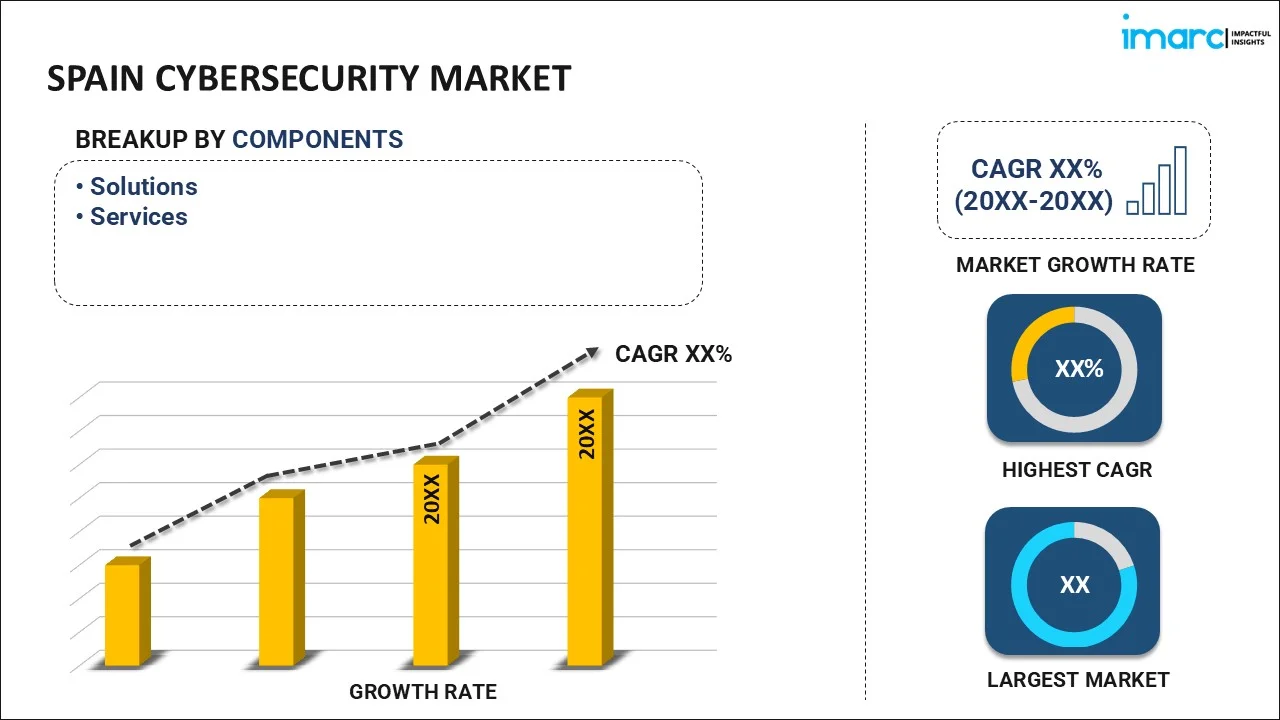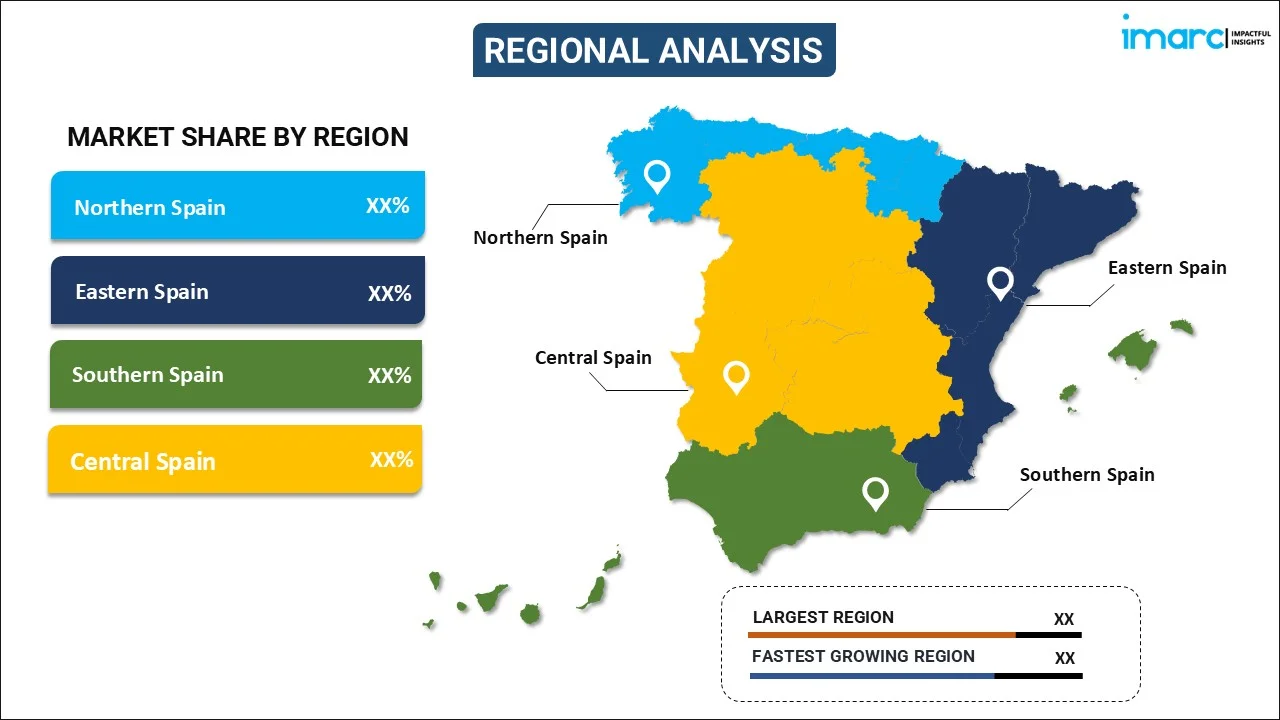
Spain Cybersecurity Market Size, Share, Trends and Forecast by Component, Deployment Type, User Type, Industry Vertical and Region, 2025-2033
Spain Cybersecurity Market Overview:
The Spain cybersecurity market size reached USD 4.82 Billion in 2024. Looking forward, IMARC Group expects the market to reach USD 10.73 Billion by 2033, exhibiting a growth rate (CAGR) of 9.30% during 2025-2033. The market is propelled by growing digital transformation in industries, escalating cyber threats, and more stringent regulatory needs such as GDPR. Increasing use of cloud services, the requirement for data protection, and increased awareness among companies regarding cyber threats are also major drivers of market growth in the nation.
|
Report Attribute
|
Key Statistics
|
|---|---|
|
Base Year
|
2024 |
|
Forecast Years
|
2025-2033
|
|
Historical Years
|
2019-2024
|
| Market Size in 2024 | USD 4.82 Billion |
| Market Forecast in 2033 | USD 10.73 Billion |
| Market Growth Rate (2025-2033) | 9.30% |
Spain Cybersecurity Market Trends:
Growing Adoption of Cloud Security Solutions in Spain
The advent of cloud computing has had a profound effect on the Spain cybersecurity market growth, with the need for cloud security solutions increasing dramatically. As per the State of the Cloud in Spain 2023, 45% of Spanish companies have adopted a hybrid cloud strategy, with 90% operating within a multi-cloud environment as the cloud plays an increasingly important role. With more companies moving to cloud platforms, they are exposed to greater threats of data breaches, cyberattacks, and unauthorized access. As a result, businesses are more and more focused on strong cloud security controls to safeguard confidential data and ensure compliance with regulatory requirements such as the GDPR. The practice has contributed to the use of sophisticated cloud security technologies, including encryption, identity and access management (IAM), and multi-factor authentication (MFA), that secure data in public, private, and hybrid clouds. Spain's digitalization across sectors, such as finance, healthcare, and retail, has also driven the need for cloud security services further. Spain's robust regulatory framework, such as laws that prioritize cybersecurity for companies, has also led to companies investing in end-to-end cloud security solutions. Certain acts and derivatives comprise the Network and Information Security (NIS) Directive, which establishes standard EU security levels for network and information systems. The Directive aims to tackle dangers to the digital economy backed by these systems. The Digital Operations Resilience Act (DORA) establishes consistent standards for the security of network and information systems, especially for financial institutions. The legislation is said to take effect in 2025. As cloud services keep growing, the Spain cybersecurity market outlook shows an emphasis on securing cloud infrastructures and on reducing possible vulnerabilities, which is fueling the market for cloud-based security solutions.
Increasing Focus on Cybersecurity for Small and Medium-Sized Enterprises (SMEs)
Spanish small and medium-sized enterprises (SMEs) are also finding it vital to implement cybersecurity as they continue to digitize their business operations. The European Union Agency for Cybersecurity shows that SMEs constitute 99% of all firms within the EU and employ around 100 million people. SMEs make up more than half of Europe's GDP and play a pivotal role in adding value in every sector of the EU economy. Whereas in the past SMEs were viewed as less susceptible to cyber-attacks because of their size, the advent of high-tech cyberattacks has changed the view. Cyber attackers are increasingly focusing on SMEs, taking advantage of their relatively weaker security setup and lack of specialized resources to counter cyber threats. In turn, SMEs are making investments in cybersecurity solutions that suit their particular needs, including budget-friendly security-as-a-service products, threat detection, and data protection solutions. In addition, the Spanish government and industry organizations are fostering awareness about the increased threats to SMEs and advocating the use of cybersecurity best practices. Consequently, the Spain cybersecurity market share is experiencing rapid growth due to the heightened demand for low-cost and scalable security solutions that will help protect SMEs against a broad array of cyber threats. This is likely to persist as more SMEs focus on cybersecurity to protect their digital assets and ensure business continuity in a rapidly interconnected digital economy.
Spain Cybersecurity Market Segmentation:
IMARC Group provides an analysis of the key trends in each segment of the market, along with forecasts at the regional level for 2025-2033. Our report has categorized the market based on component, deployment type, user type, industry vertical and region.
Component Insights:

- Solutions
- Identity and Access Management (IAM)
- Infrastructure Security
- Governance, Risk and Compliance
- Unified Vulnerability Management Service Offering
- Data Security and Privacy Service Offering
- Others
- Services
- Professional Services
- Managed Services
The report has provided a detailed breakup and analysis of the market based on the component. This includes solutions (identity and access management (IAM), infrastructure security, governance, risk and compliance, unified vulnerability management service offering, data security and privacy service offering, and others), services (professional services, and managed services).
Deployment Type Insights:
- Cloud-based
- On-premises
A detailed breakup and analysis of the market based on the deployment type has also been provided in the report. This includes cloud-based and on-premises.
User Type Insights:
- Large Enterprises
- Small and Medium Enterprises
A detailed breakup and analysis of the market based on the user type has also been provided in the report. This includes large enterprises, and small and medium enterprises.
Industry Vertical Insights:
- IT and Telecom
- Retail
- BFSI
- Healthcare
- Defense/Government
- Manufacturing
- Energy
- Others
A detailed breakup and analysis of the market based on the industry vertical has also been provided in the report. This includes IT and telecom, retail, BFSI, healthcare, defense/government, manufacturing, energy, and others.
Regional Insights:

- Northern Spain
- Eastern Spain
- Southern Spain
- Central Spain
The report has also provided a comprehensive analysis of all the major regional markets, which include Northern Spain, Eastern Spain, Southern Spain, and Central Spain.
Competitive Landscape:
The market research report has also provided a comprehensive analysis of the competitive landscape. Competitive analysis such as market structure, key player positioning, top winning strategies, competitive dashboard, and company evaluation quadrant has been covered in the report. Also, detailed profiles of all major companies have been provided.
Spain Cybersecurity Market News:
- In January 2025, Telefónica Tech and IBM announced the formation of a partnership for quantum-safe technology. Telefónica Tech wants to integrate IBM's quantum safe technology into its cybersecurity solutions to create specific applications that address current and future threats associated with the emergence of cryptographically relevant quantum computers. The agreement includes the implementation of IBM quantum-safe technology infrastructure at Telefónica Tech headquarters in Madrid (Spain) to support business expansion centered on cyber resilience and resilience to threats resulting from the appearance of future cryptographically relevant quantum computers.
- On December 12, 2024, Telefónica Tech and CrowdStrike announced a strengthened partnership to provide the CrowdStrike Falcon® cybersecurity platform access to SMBs in Spain through Telefonica Tech's 'Tu Empresa Segura' solution. With this partnership, Telefónica Tech will bring premier endpoint protection and Managed Detection and Response (MDR) services enriched by the Falcon platform to SMB customers.
Spain Cybersecurity Market Report Coverage:
| Report Features | Details |
|---|---|
| Base Year of the Analysis | 2024 |
| Historical Period | 2019-2024 |
| Forecast Period | 2025-2033 |
| Units | Billion USD |
| Scope of the Report |
Exploration of Historical Trends and Market Outlook, Industry Catalysts and Challenges, Segment-Wise Historical and Future Market Assessment:
|
| Components Covered |
|
| Deployment Types Covered | Cloud-based, On-premises |
| User Types Covered | Large Enterprises, Small, Medium Enterprises |
| Industry Verticals Covered | IT and Telecom, Retail, BFSI, Healthcare, Defense/Government, Manufacturing, Energy, Others |
| Regions Covered | Northern Spain, Eastern Spain, Southern Spain, Central Spain |
| Customization Scope | 10% Free Customization |
| Post-Sale Analyst Support | 10-12 Weeks |
| Delivery Format | PDF and Excel through Email (We can also provide the editable version of the report in PPT/Word format on special request) |
Key Questions Answered in This Report:
- How has the Spain cybersecurity market performed so far and how will it perform in the coming years?
- What is the breakup of the Spain cybersecurity market on the basis of component?
- What is the breakup of the Spain cybersecurity market on the basis of deployment type?
- What is the breakup of the Spain cybersecurity market on the basis of user type?
- What is the breakup of the Spain cybersecurity market on the basis of industry vertical?
- What is the breakup of the Spain cybersecurity market on the basis of region?
- What are the various stages in the value chain of the Spain cybersecurity market?
- What are the key driving factors and challenges in the Spain cybersecurity market?
- What is the structure of the Spain cybersecurity market and who are the key players?
- What is the degree of competition in the Spain cybersecurity market?
Key Benefits for Stakeholders:
- IMARC’s industry report offers a comprehensive quantitative analysis of various market segments, historical and current market trends, market forecasts, and dynamics of the Spain cybersecurity market from 2019-2033.
- The research report provides the latest information on the market drivers, challenges, and opportunities in the Spain cybersecurity market.
- Porter's five forces analysis assist stakeholders in assessing the impact of new entrants, competitive rivalry, supplier power, buyer power, and the threat of substitution. It helps stakeholders to analyze the level of competition within the Spain cybersecurity industry and its attractiveness.
- Competitive landscape allows stakeholders to understand their competitive environment and provides an insight into the current positions of key players in the market.
Need more help?
- Speak to our experienced analysts for insights on the current market scenarios.
- Include additional segments and countries to customize the report as per your requirement.
- Gain an unparalleled competitive advantage in your domain by understanding how to utilize the report and positively impacting your operations and revenue.
- For further assistance, please connect with our analysts.
 Inquire Before Buying
Inquire Before Buying
 Speak to an Analyst
Speak to an Analyst
 Request Brochure
Request Brochure
 Request Customization
Request Customization




.webp)




.webp)












